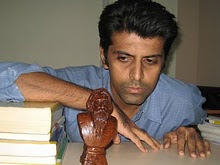An August Miscellany
Alternative title: 'Miscellany in August' (What say, Kuro?)
How now, Blue Cow?
Looking out from the Delhi-bound Prayagraj express as it coasted between Aligarh and Ghaziabad one steamy monsoon dawn, I saw an unfamiliar animal - somewhat taller and leaner than a bull, dark coated and well-muscled and with small horns. It was grazing in a freshly planted field.
Here are some Wiki details on the beast, commonly called the nilgai.
For centuries Indian villagers have associated the nilgai with the cow, a sacred animal revered by Hindus, and the name ("gai" means "cow" in Hindi) indicates the similarity they saw with the cow. The nilgai is rarely consumed by Hindus due to its religious significance. Tribes such as the Bishnois traditionally take care of wild animals like the nilgai....
The governments of Bihar, Maharashtra and Uttarakhand have urged the Government of India to declare the nilgai as vermin... As the name "nilgai" appeals to the religious sentiments of Hindus, the Government of Madhya Pradesh has sought to officially rename it as rojad (Hindi for "forest antelope") and the Government of Haryana to rename it as roze in a bid to make their culling acceptable...
Wiki also says the nilgai used to be called the "blue horse" during the time of Aurangzeb. As per the official 21st century image of the emperor, he would rather have called it the "blue cow" and slaughtered it to extinction. And at least from a Malayali viewpoint (the reason for bringing in the Mal angle here will remain unspecified), to call a horned animal any kind of horse is utterly stupid.
Lucifer
New Delhi, which I walked over intensively on the same day, is a strange place. One sees many restaurants, the majority of them quite swanky (in particular, there are about half a dozen in a small shopping center off Pandara road) but none was open during 7 am- 11 am. I was told they start at midday and stay open almost till daybreak. Wonder what it could be about the daily routine - and nightlife - of the city that warrants such timings. Indeed, to my knowledge the only eating place functioning in the above time window in a two kilometer radius of Pandara road operates out of a shed behind a sarkari office with infrastructure limited to a single bench and table and without running water.
(Aside: Must also say it was quite pleasing to see roads named after Bhavabhuti (ancient playwright considered second only to Kalidasa by many) and Copernicus)
Wearily trudging back to the railway station past Connaught place, I saw this figure hovering over a still closed restaurant.

The irony of a dark, winged and hoofed purveyor of illumination struck me. Looking around Wiki, it was a shock to know that ancient Biblical tradition viewed the brilliant Venus or Morning Star not as joyous harbinger of a new day but as a symbol of the tyrannical king Nebuchednezzer and even the Devil himself. The later name Lucifer (="light bringer") rose from this concept.
Aside: Wonder why at least a few Kerala Christians are named 'Nebu' - Reminiscent of 'Korah'.
On Identity
Another Bible, Grady ("the daddy") Booch's textbook on Object Oriented Analysis has this picture: "Every object has a state, behavior and identity"

One morning, at the elephant yard behind Tripunithura temple, I saw a freshly instantiated variant of the third portion of the above triptych:

Khasak and Translation Woes:
"Saar, aarum chaavaatha katha!" that was Kunhamina specifying the type of story she would want to hear from Ravi.
I recall struggling to translate the phrase: "Aarum chaavaatha katha". A literal translation would be "A story in which no one dies" but that's too clumsy. The problem comes from the unique way the genius of Malayalam (equally Tamil) creates an adjective like 'aarum chaavaatha'; English (or Hindi for that matter) has nothing like a counterpart. (*)
"A story without death" would be inappropriately heavy - the reason being that Kunhamina is an as-yet-unlettered ten year old girl. I could identify with her angst about mortality but injecting the abstraction of 'death' would ruin the direct simplicity of her demand.
I ended up with "a story where no one dies!" - strictly speaking, wrong because a story is no location in space. But the translation had brevity - and methought that is about as close as English can get.
After many years of dithering, I have actually bought the English version of Khasak written by Vijayan himself. And here is what the Master has made Kunhamina say: "a story without dying!"
------------
(*) To give another example from the same ballpark (I owe this to old friend Anil), 'pusthakangalilillaatha vivarangal' is the type of phrase routinely said in Malayalam. vivarangal means 'matters' but the two-word phrase can be said in English only as "matters which cannot be found in books"!
Aside: Recently, I saw the Malayalam "akkarekkaavil" translated as "At the temple on the other bank of the river". The translation is bad, and inevitably so! Indeed, 'akkare' only means 'on the other bank' but does not specify the type of the water body involved - it could be a river or a 'kayal'. And to translate 'kaavu' as 'temple' is criminally inadequate. A kaavu is a very specialized Keralan sanctuary and all its character is lost in the bald 'temple'.

